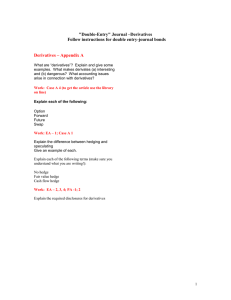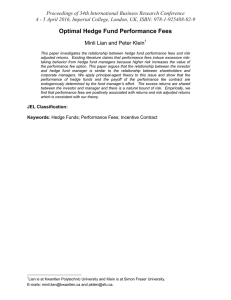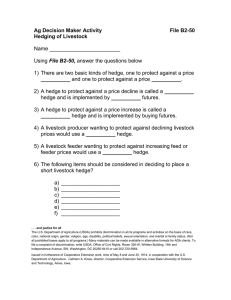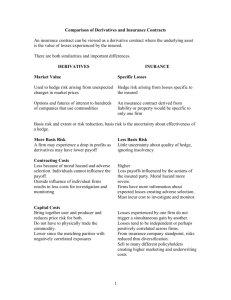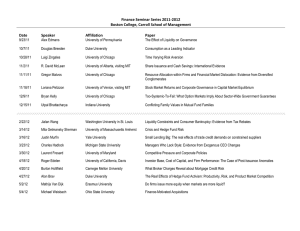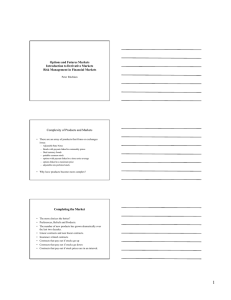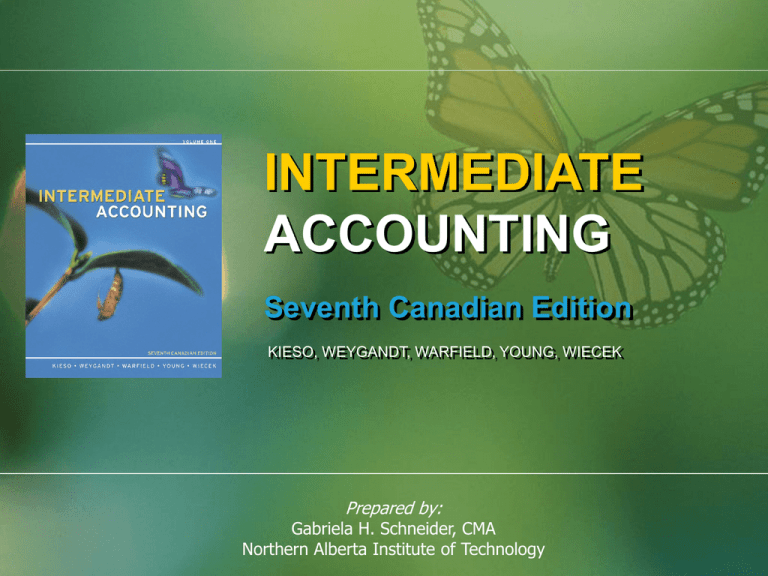
INTERMEDIATE
ACCOUNTING
Seventh Canadian Edition
KIESO, WEYGANDT, WARFIELD, YOUNG, WIECEK
Prepared by:
Gabriela H. Schneider, CMA
Northern Alberta Institute of Technology
Appendix 17A
Hedging
Learning Objectives
10. Understand how derivatives are used in
hedging.
11. Explain what hedge accounting is and identify
the qualifying hedge criteria.
12. Explain the difference between a fair value and
cash flow hedge.
13. Calculate the impact on net income using
hedge accounting for both types of hedges.
Derivatives Used For Hedging
• Financial risks faced by organizations:
– Price risk
• Fair value impact on assets and liabilities
– Cash flow risk
• Risk due to variability of cash flow
– Liquidity risk
• Cash flow commitments
– Credit risk
• Cash flow commitments
• Derivatives used to offset these fair value and cash
flow risks
Hedging
•
•
Used to manage interest rate and foreign
exchange risk
Two types of hedges
1. Fair Value Hedge
2. Cash Flow Hedge
Hedging
• Fair Value Hedge
– To offset exposure to fair value changes of
• Recognized asset or liability
– Examples are
• Put option
• Forward contract
• Cash Flow Hedge
– Offset risks of future transactions
– Gains/losses reported as part of Other
Comprehensive Income
Optional Hedge Accounting
•
Available as an accounting option when the following
are met:
1. When the hedge is entered into
a. Identify the exposure
b. Designate that hedge accounting applied
c. Document risk management objectives and
strategies
2. Reasonable assurance should exist that the
firms’ risk management policy is being
maintained
a. Hedge effectiveness can be reasonably
measured
b. Hedge is reassessed as regular intervals
Forward Contract as Fair Value
Hedge
• Commitment to sell an instrument/investment
at a pre-determined price
• Eliminates the risk of a price decrease
Fair Value Hedge - Example
• Investment (intended for sale) purchased at a
cost of: $1,000
Journal entry to purchase
Investment
1,000
Cash
1,000
• Forward contract entered into
Fair Value Hedge - Example
• At year end assume investment value is
$1,050
Journal entry:
Investment
50
Gain on Investment
50
and
Loss on Investment
50
Investment-Derivative
50
• No effect on cash flows
Fair Value Put Option - Example
• Under hedge accounting
• Gain is recorded on the hedged item
and
• Loss is recorded on the underlying derivative
• Applies also to losses
Cash Flow Hedge - Examples
•
•
•
•
Interest rate swaps used as hedges
Similar in nature to forward contracts
Requires two parties to enter into
Payments are made under a fixed or floating
rate of interest
• Payments then made by the second party
– Terms are the opposite of the original payment
terms
Interest Rate Swap
A pays B at a fixed (or floating) rate
Party A
Financial
Intermediary
Party B
B pays A using the opposite rate of A
Interest Rate Swap
Given:
Jones enters into a 5-year interest rate swap with B
Terms are:
Jones will make payments at the fixed rate of 8%
Jones will receive payments at variable rate (6.8%
when contract entered into)
Principal sum involved is $1,000,000
Interest Rate Swap
• No entry required when swap entered into
• Fair value of the swap reported on the Balance
Sheet
• Any gains or losses reported through other
Comprehensive Income until realized through
interest expense
Interest Rate Swap
• Value of the swap determined at the end of
each year
• Based on the difference between the fixed
(contract) rate and the prevailing rate of
interest
• Value of the swap contract reported on the
Balance Sheet at fair market value
• Any gain reported as part of Comprehensive
Income
• Value at the end of the swap contract is zero
Forward Contract as a Cash Flow
Hedge
• Forwarding contracts may be used to hedge
anticipated future transactions (and the
associated cash flow risks) i.e. a purchase
commitment
• Gives the holder the right to purchase at a preset
price
• Unrealized gains or losses are recorded in Other
Comprehensive Income
• When gains/losses are realized, they are
transferred from OCI to NI
– Gain or loss arises when the spot price is
different than the forward (contract) price
Disclosure Requirements
•
Include the following:
1) Terms and conditions of instrument
2) Interest rate risk
3) Credit risk, including significant
concentrations
4) Fair value of any and all recognized and
unrecognized financial instruments
5) Hedges
1) Description of hedge
2) Type of hedge used
COPYRIGHT
Copyright © 2005 John Wiley & Sons Canada, Ltd.
All rights reserved. Reproduction or translation of
this work beyond that permitted by Access Copyright
(The Canadian Copyright Licensing Agency) is
unlawful. Requests for further information should be
addressed to the Permissions Department, John
Wiley & Sons Canada, Ltd. The purchaser may make
back-up copies for his or her own use only and not
for distribution or resale. The author and the
publisher assume no responsibility for errors,
omissions, or damages caused by the use of these
programs or from the use of the information
contained herein.


